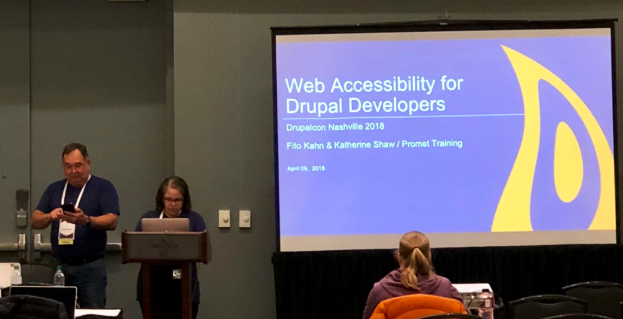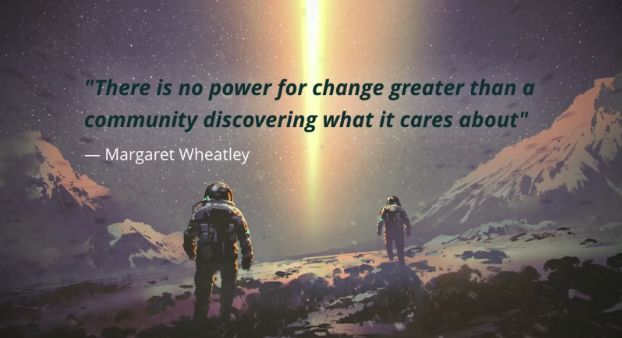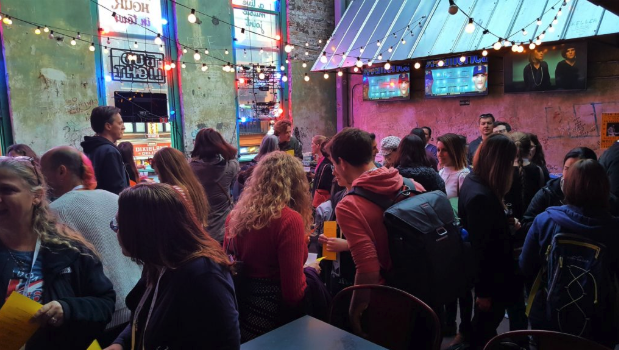Space for Empathy

Last month I went to my first DrupalCon in Nashville. I met a lot of interesting people, had good conversations, and had a hard time choosing from the record number of sessions. As the week went on, I noticed a theme kept coming up. It showed up in sessions on how to create a better admin and content editing experience, in sessions on accessibility and what it’s like to be a blind or deaf engineer, in conversations about helping first-time users enjoy the experience of using Drupal, and in debates about what Drupal will look like in the future. What if the thing that will give Drupal a competitive advantage and improve the admin experience is the same thing that will attract new users and create sites that are accessible for all?
The idea that kept surfacing during my week at DrupalCon was this: we need empathy. The Drupal community has excelled at solving complex engineering problems, and the next challenge we face is just as critical, though it requires us to think a little differently: how do we make space for empathy in our work and in our community?

It’s time to shift our perspective. Photo Credit: Randy Jacob.
Our Bias is our Blindspot
Sometimes we don’t need more complex solutions, we need thoughtful ones. Building websites is challenging. There’s never enough time or resources. It’s easy to stick with what’s known and what works. But sometimes what I know is limited, and only works for people who look and think like me. It’s easy to become insular and indifferent to the needs of others because it’s hard to make everyone happy, and thinking about the effort required to change can be overwhelming.
If someone told me, “It’s really hard to talk to people with accents, so I just avoid them,” I’d be shocked. But I know I’ve created sites and tools that are difficult—if not impossible—for people with disabilities to use. Arriving in Nashville, I knew enough about accessibility to know that I needed to learn more. So I dove in and attended every session I could.

I kicked off my deep dive with Katherine Shaw and Fito Kahn’s awesome all day Drupal Accessibility training. Check out Katherine Shaw’s great blog posts on accessibility.
Accessible Empathy
I learned that excuses like “accessibility is hard,” or “it doesn’t affect me because I’m not working on a government site” won’t get me off the hook. Accessible websites are now a part of the Americans with Disabilities Act. And any site that is not accessible to all users is liable. I met several engineers who are currently resolving warnings or navigating lawsuits for not meeting WCAG 2.0 guidelines.
But it’s about much more than just changing processes to avoid a lawsuit. Listening to the Core Accessibility panel, I was humbled when it was pointed out that we labor over fixes for Internet Explorer, which can make up 2-3% of users. Meanwhile, 12.6% of people in the US have disabilities (40.7 million people), and accessibility can still be considered an edge case. Building a website that works for more users is not difficult, but it takes intention, a willingness to learn and empathy.
I also learned that having empathy for all types of users doesn’t mean everything has to change immediately. During his talk about accessibility, Everett Zufelt said, “The best place to start? Anywhere. If you fix one button, your site is that much more accessible than it was before.” So I’m challenging myself to build things the right way the first time, drop bad habits and to refine best practices so I can create sites and tools that serve all types of users.
Inward Empathy
For some of you reading this, the challenge might be that you have empathy for everyone in the room, except yourself. You take on multiple roles at work. You handle the backend and the frontend and design and project management. You say yes because you know you can do it and how will you get ahead if you don’t show how valuable you are by doing all of the things all the time? I get it. Now stop it.

“ ‘No’ might make them angry, but it will make you free.” –Nayyirah Waheed; Photo credit: Clem Onojeghuo
You deserve empathy too, so be kind to yourself. Good boundaries will keep you fresh and sane. A well cared for version of you will help your team more than the stretched and exhausted one that’s running on too little sleep and too much caffeine.
Something that stood out to me in particular in sessions at DrupalCon was how people wouldn’t move over in their seats to make room and allow those in an already crowded session to sit comfortably in chairs instead of on the floor. People would have empty seats on either side, and not move down the row to make it easier others. There are people who don’t have an issue taking up space, taking what they need, and not for an instant feeling bad about it. Let’s find some balance somewhere in the middle. Give yourself the empathy you need to succeed, and–for the love of god–let’s all scoot down so no one is left sitting on the floor.
Outward Empathy
A better admin experience, and faster and more accessible websites are only created when we think about how our work is used by everyone. Take a moment to walk a mile in someone else’s shoes. Now apologize for taking their shoes, sit down and talk to them about how they use your site, what the sticking points are, and how it can be improved. Most importantly, listen. Forget what you think you know, and learn about what it means to be someone else using your website. Then you just might have a week like mine where you were reminded: sometimes engineers are blind or deaf, or both. Sometimes keynotes are a she or a he or a they. Sometimes content editors know exactly what is needed to make a better editing experience–if you just ask.
Be Human. Think Digital.
Empathy is what makes us human. We all want to be seen and known and understood. And at the end of the day we all want to use tools that help us to accomplish a task, not remind us that we’re not who the engineer had in mind. Technology without empathy is hollow. Empathy without technology is limited. Let’s make space for empathy in our community and in our code, and let’s change the world for good—for everyone.

One of my favorite slides from the Driesnote at DrupalCon Nashville

The ThinkShout team hanging out with some awesome folks at the Women in Drupal event.
Resources
If you’re interested in learning more about the sessions I attended this week, here are links to some of my favorite talks:
If you’re overwhelmed by accessibility and don’t know where to start, here’s a great video on how to do a very basic accessibility audit.
If you’re interested in refining your accessibility practices, there are some amazing tools and resources available. Here are some of my favorites. If you have tools or processes you love, please share in the comments below!
Style Guide Module: Allows you to run accessibility tests on one page that is automatically populated with all basic layout elements. This is also great as a living style guide for the site.
A11y checklist: A11y has a ton of patterns and a useful checklist.
WAVE Accessibility Plugin: Described in the “A smarter Way to Test Accessibility” talk as the ‘Cadillac of accessibility plugins,” this free tool will catch errors, markup the page with an outline of your headings and make accessibility QA much easier.
Sim Daltonism tool: This overlay tool allows you to preview your site for multiple types of colorblindness.
Color Contrast Ratio Checker: This chrome plugin will tell you whether the color contrast of fonts on your site passes WCAG 2.0 standards.
ARIA cheat sheet: This doc outlines all of the different ways you can use ARIA to make your site more accessible
HTML Codesniffer by Squiz: Allows you to set the accessibility standard you want to meet (WCAG2AA is the new legal requirement), and creates a report identifying errors, warnings and notices.